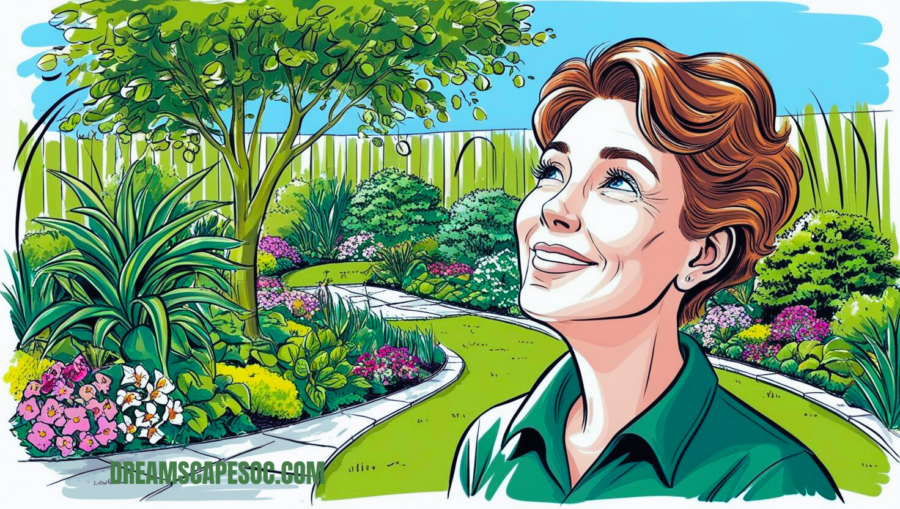Sustainable Landscaping using Xeriscaping Techniques
Xeriscaping Techniques design and maintain gardens that use minimal water without sacrificing beauty or functionality; unlike traditional landscaping methods, which often rely on extensive irrigation and high water consumption, xeriscaping leverages natural principles to create self-sustaining landscapes that thrive in dry conditions.
Xeriscaping is not merely about choosing drought-tolerant plants; it encompasses a comprehensive strategy that includes soil management, efficient irrigation, and thoughtful design. The term “xeriscaping” derives from the Greek word “xeros,” meaning dry, reflecting the core philosophy of this landscaping method.
The benefits of xeriscaping extend beyond water conservation. By integrating xeriscaping techniques, gardeners can reduce maintenance requirements, lower utility bills, and support local ecosystems.
This guide will delve into the essential xeriscaping techniques, providing a detailed exploration of methods, plant choices, and maintenance practices. Whether you are a seasoned gardener looking to adapt to water-efficient practices or a newcomer eager to create a low-maintenance garden, understanding these techniques will empower you to make informed decisions. From planning and plant selection to soil improvement and irrigation strategies, this article aims to equip you with the knowledge needed to embrace xeriscaping and transform your garden into a sustainable oasis.
Join us as we explore the principles of xeriscaping, discover practical tips for implementation, and uncover the many advantages of this eco-friendly landscaping approach. By adopting xeriscaping techniques, you can contribute to water conservation efforts while enjoying a vibrant and resilient garden that flourishes in any climate.
Click here for instant access to Landscape Design Ideas.
Overview: What is Xeriscaping?
Unlike traditional Landscaping, which often relies on high water usage and frequent irrigation, xeriscaping focuses on creating a self-sustaining garden that requires minimal supplemental watering. This approach conserves water, reduces maintenance efforts, and supports local ecosystems.
Transform Your Outdoor Space Today – Download Your Free Landscaping and Gardening Checklist
Key Xeriscaping Techniques
Plan Your Landscape
- Purpose: Designing a xeriscape garden begins with careful planning to ensure efficient water use and functional aesthetics.
- Key Points:
-
- Assess your garden’s sunlight exposure, soil type, and drainage.
- Design plant zones based on water needs.
- Incorporate hardscaping elements to reduce water requirements.
Choose Drought-Tolerant Plants
- Purpose: Selecting plants that thrive in dry conditions is crucial for a successful xeriscape.
- Key Points:
-
- Opt for native and adapted species.
- Group plants with similar water needs together.
- Use groundcovers, shrubs, and grasses that require minimal watering.
Improve Soil Quality
- Purpose: Enhancing soil structure supports healthy plant growth and efficient water use.
- Key Points:
- Fertility and water retention.
- Avoid heavy clay soils by incorporating sand or perlite.
Implement Efficient Irrigation Systems
- Purpose: Efficient irrigation methods ensure plants receive the right amount of water without waste.
- Key Points:
-
- Group plants by their water needs to optimize irrigation.
Use Mulch
- Purpose: Mulching conserves soil moisture and suppresses weed growth.
- Key Points:
-
- Maintain a 2-4-inch layer to reduce evaporation.
- Replace mulch as needed to maintain effectiveness.
Design for Water Efficiency
- Purpose: Incorporate design elements that enhance water conservation and reduce runoff.
- Key Points:
-
- Create contour beds to capture and direct rainwater.
- Install permeable paving to allow water infiltration.
- Incorporate water features like rain gardens to manage runoff.
Xeriscaping Techniques Breakdown
| Technique | Description | Benefits | Examples |
| Plan Your Landscape | Design garden layout considering sunlight, soil, and water needs | Efficient water use, functional design | Zoned planting areas, hardscaping elements |
| Choose Drought-Tolerant Plants | Select plants suited to dry conditions | Low maintenance, water conservation | Succulents, native grasses, drought-tolerant shrubs |
| Improve Soil Quality | Enhance soil with organic matter and improve drainage | Better plant health, water retention | Compost addition, soil amendments |
| Implement Efficient Irrigation Systems | Use methods like drip irrigation and rain barrels | Reduced water waste, targeted watering | Drip irrigation, rain barrels, soaker hoses |
| Use Mulch | Add mulch to retain moisture | Moisture conservation, weed control | Wood chips, straw, gravel mulch |
| Design for Water Efficiency | Incorporate features that capture and manage rainwater | Reduced runoff, enhanced water usage | Contour beds, permeable paving, rain gardens |

Tips for Successful Xeriscaping
- Start Small: Begin with a manageable area to practice xeriscaping techniques before expanding.
- Research Local Plants: Choose species well-suited to your local climate and soil conditions.
- Monitor and Adjust: Regularly check soil moisture and plant health to adjust watering and maintenance.
- Educate Yourself: Stay informed about new xeriscaping practices and innovations to improve your garden.
Questions About Xeriscaping
What is xeriscaping?
It focuses on conserving water through careful planning, plant selection, and maintenance practices.
How does xeriscaping save water?
Xeriscaping saves water by:
- Selecting Drought-Tolerant Plants: These plants require less water once established and are well-adapted to local conditions.
- Improving Soil Quality: Enhancing soil structure with organic matter helps retain moisture.
- Efficient Irrigation Systems: Use to reduce waste.
- Mulching: Mulch retains soil moisture and reduces evaporation.
- Design Features: Techniques such as contour beds and permeable paving help manage and capture rainwater, reducing runoff and conserving resources.
Can xeriscaping be applied in all climates?
While xeriscaping is particularly effective in dry climates, its principles can be adapted to various climates. In humid or cooler regions, xeriscaping practices such as efficient irrigation, soil improvement, and mulch can still enhance water efficiency and reduce maintenance.
What types of plants are best for xeriscaping?
The best plants for xeriscaping are:
- Drought-tolerant plants such as succulents, cacti, and certain native grasses require minimal water.
- Native Plants: Plants native to your region are adapted to local climate and soil conditions, making them ideal for xeriscaping.
- Groundcovers: Low-growing plants that spread quickly and reduce the need for supplemental watering.
- Perennials: Many perennial plants are drought-resistant and can provide long-lasting beauty with minimal care.
How often should I water a xeriscaped garden?
The watering frequency for a xeriscaped garden depends on factors such as plant types, soil conditions, and weather. Generally, xeriscaped gardens need less frequent watering than traditional gardens. It’s best to monitor soil moisture and water only when necessary, typically once every 1-2 weeks during dry periods. Adjust watering based on plant needs and local weather conditions.
Can I incorporate lawns into a xeriscaped garden?
Yes, lawns can be included in a xeriscaped garden by choosing drought-tolerant grass varieties and using water-efficient irrigation methods. Consider alternative ground covers or low-water grass options requiring less maintenance and water than traditional lawn grasses.
What are the benefits of xeriscaping beyond water conservation?
Xeriscaping offers several benefits beyond water conservation:
- Reduced Maintenance: Drought-tolerant plants typically require less upkeep.
- Cost Savings: Lower water bills and reduced need for chemical fertilizers and pesticides.
- Environmental Impact: Less water usage conserves local resources and supports sustainable gardening practices.
- Biodiversity: Enhances the garden’s ecological value.
How do I start a xeriscaping project?
To start a xeriscaping project:
- Assess Your Site: Evaluate sunlight exposure, soil type, and drainage.
- Plan Your Design: Create a layout that includes zones for different water needs and incorporates hardscaping features.
- Select Appropriate Plants: Choose drought-tolerant and native species suited to your climate.
- Prepare the Soil: Improve soil quality with organic matter and ensure proper drainage.
- Install Efficient Irrigation: Use drip systems or soaker hoses for targeted watering.
- Add Mulch and Design Features: Mulch retains moisture and incorporates design elements that manage rainwater.
What is the role of mulch in xeriscaping?
Mulch plays a crucial role in xeriscaping by:
- Retaining Soil Moisture: Mulch is a barrier to reducing evaporation, helping keep the soil moist longer.
- Suppressing Weeds: A layer of mulch prevents the growth of weeds.
- Improving Soil Quality: As mulch decomposes, enhancing its structure and water-holding capacity.
Are there any common misconceptions about xeriscaping?
Common misconceptions about xeriscaping include:
- Does Xeriscaping Mean a Lack of Plants? It does not mean a barren landscape but a thoughtfully designed garden with suitable, low-water plants.
- Xeriscaping is Only for Desert Climates: Xeriscaping principles can be adapted to various climates, not just arid regions.
- Xeriscaping is Too Expensive: While initial costs may vary, xeriscaping can save money in the long run through reduced water bills and lower maintenance needs.
How can I maintain a xeriscaped garden?
Maintaining a xeriscaped garden involves:
- Monitoring Soil Moisture: Check the soil regularly to avoid overwatering or underwatering.
- Pruning and Trimming: Keep plants healthy and remove dead or damaged growth.
- Weed Control: Keep weeds in check to prevent competition for water and nutrients.
- Seasonal Adjustments: Adjust irrigation and maintenance practices based on
Whether new to xeriscaping or looking to refine your practices, these insights will help you create a sustainable and beautiful landscape.
Conclusion
Xeriscaping offers an innovative approach to Landscaping that prioritizes water conservation while creating beautiful and functional outdoor spaces. You can enjoy a thriving garden with minimal water use by carefully planning, selecting drought-tolerant plants, improving soil quality, and using efficient irrigation methods.


